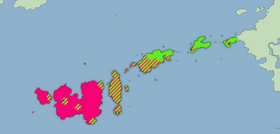Soc'ul'
| Soc'ul' | |
|---|---|
| soc'ul' | |
 Jul soc'ul', "Soc'ul' language" | |
| Pronunciation | [so̞˧kʷʰu˩lˀ] |
| Created by | Dillon Hartwig |
| Date | 2020 |
| Setting | Pollasena |
| Native to | Knrawi Isles |
| |
Early form | |
| Official status | |
Official language in | Knrawi Empire |
Range map of Soc'ul' (green) and Knrawi (pink) | |
Soc'ul' [so̞˧kʷʰu˩lˀ] is a Wasc language spoken primarily by the Cuoñ'o people, with strong influence from Knrawi and other languages of the Knrawi Isles.
Etymology
Soc'ul', the language's autonym, is inherited from the Pre-Soc'ul' autonym səkʰulːa, from Wascotl *(cek)-cek-sole-la "our tongue".
Orthography
Soc'ul' is written with the Wacag logography. Its romanization is as follows.
| A a | Á á | Ā ā | B b | B' b' | C c | C' c' | D d | D' d' | E e | É é | Ē ē | H h | I i | Í í | Ī ī |
| J j | L l | L' l' | M m | M' m' | N n | N' n' | Ñ ñ | Ñ' ñ' | O o | Ó ó | Ō ō | P p | Pf pf | R r | R' r' |
| S s | T t | Ts ts | Tx tx | T' t' | U u | Ú ú | Ū ū | V v | V' v' | X x | Y y | Ý ý | Z z | Z' z' |
This romanization matches IPA except
- ⟨c⟩, ⟨e⟩, ⟨h⟩, ⟨j⟩, ⟨ñ⟩, ⟨x⟩, and ⟨y⟩ represent /k/, /ə/, /ʔ/, /x/, /ŋ/, /ʃ/, and /ɰ/
- ⟨pm⟩, ⟨tn⟩, ⟨cñ⟩, ⟨pf⟩, ⟨ts⟩, and ⟨tx⟩ represent /ᵖm/, /ᵗn/, /ᵏŋ/, /p͡f/, /t͡s/, and /t͡ʃ/
- ⟨o⟩ represents /ə/ when realized as [o̞] except between a labialized consonant (except allophones of /u(ː)/) and a plain velar consonant (except /ɰˀ/)
- Apostrophes mark glottalization and aspiration.
- Acutes and macrons mark long and overlong vowels respectively, except in ⟨ý⟩ in which it marks glottalization.
- Labialization and palatalization are marked by surrounding vowel letters.
Phonology
Consonants
| Labial/ labiodental |
Alveolar | Post- alveolar |
Palatalized velar/ palatal |
Velar | Labialized velar | Glottal | ||||||||||||||||||||||
|---|---|---|---|---|---|---|---|---|---|---|---|---|---|---|---|---|---|---|---|---|---|---|---|---|---|---|---|---|
| Nasal | ᵖm | m | ᵖmˀ | mˀ | ᵗn | n | nˀ | ᵗnˀ | ᵏŋʲ | ŋʲ | ᵏŋʲˀ | ŋʲˀ | ᵏŋ | ŋ | ᵏŋˀ | ŋˀ | ᵏŋʷ | ŋʷ | ᵏŋʷˀ | ŋʷˀ | ||||||||
| Stop | b | bˀ | t | d | tʰ | dˀ | kʲ | kʲʰ | k | kʰ | kʷ | kʷʰ | ʔ | |||||||||||||||
| Affricate | t͡s | t͡ʃ | ||||||||||||||||||||||||||
| Fricative | v | vˀ | s | z | zˀ | ʃ | xʲ | (ʝ) | (ʝˀ) | x | (ɣ) | (ɣˀ) | xʷ | (ɣʷ) | (ɣʷˀ) | |||||||||||||
| Approximant | l | lˀ | (j) | (jˀ) | (ɰ) | (ɰˀ) | (w) | (wˀ) | ||||||||||||||||||||
| Trill | r | rˀ | ||||||||||||||||||||||||||
Notes:
- Glottalized stops are realized as implosive by some speaker either in free variation or word-initially
- [j(ˀ)] and [w(ˀ)] are allophones of /i(ː)/ and /u(ː)/ adjacent to vowels
- [j(ˀ)], /ɰ(ˀ)/, and [w(ˀ)] are realized as [ʝ(ˀ)], [ɣ(ˀ)], and [ɣʷ(ˀ)] adjacent to high vowels
Vowels
| Front | Central | Back | ||
|---|---|---|---|---|
| Close | i | (y) | u | |
| Mid | ə | (o̞) | ||
| Open | a | (ɒ) | ||
Notes:
- All vowels can be long or overlong
- [y], [o̞], and [ɒ] are allophones of /i/, /ə/, and /a/ adjacent to labialized consonants except allophones of /u(ː)/
Prosody
Stress
There is no set stress position, but an allophonic pitch system based on vowels' surrounding consonants. These pitches are not contrastive but are seen as proper and are required in recitations.
| Voiceless /pre-stopped consonant |
Aspirated /voiced consonant |
Word boundary /vowel |
Glottalized consonant | |
|---|---|---|---|---|
| Voiceless /pre-stopped consonant |
high | mid | high | low |
| Aspirated /voiced consonant |
high | mid | mid | low |
| Word boundary /vowel |
high | mid | mid | low |
| Glottalized consonant | high | mid | low | low |
| Voiceless /pre-stopped consonant |
Aspirated /voiced consonant |
Word boundary /vowel |
Glottalized consonant | |
|---|---|---|---|---|
| Voiceless /pre-stopped consonant |
high | high falling | high falling | high sharp falling |
| Aspirated /voiced consonant |
high rising | mid | mid | low falling |
| Word boundary /vowel |
high rising | mid | mid | low falling |
| Glottalized consonant | low sharp rising | low rising | low rising | low |
Whether glottalized pre-stopped nasals pattern as pre-stopped or glottalized varies by speaker and region.
Intonation
Declarative sentences generally have a falling pitch throughout, but volume and pitch range can be used for emphasis. In questions or negated sentences the particle xen may also be emphasized with a sharp falling pitch followed by higher pitch in the following word.
Rhythm
Syllables are generally mora-timed, with syllables containing long and overlong vowels having two or three morae; in recitations, continuant coda consonants or coda clusters with them may have their own mora, and overlong syllables may instead have four morae.
Phonotactics
Syllables are at most CC₁VC₂C, with C₁ being a non-lateral approximant and C₂ being C₁ or /ʔ/, but these maximum syllables are very rare. There are no restrictions on what clusters can occur.
